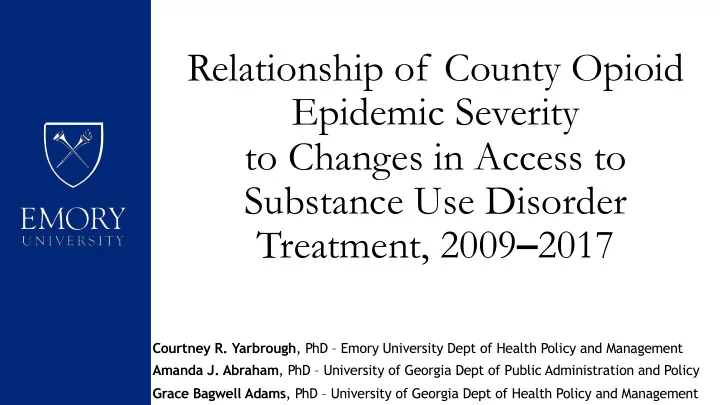

Relationship of County Opioid Epidemic Severity to Changes in Access to Substance Use Disorder Treatment, 2009 – 2017 Courtney R. Yarbrough, Ph.D. Courtney R. Yarbrough , PhD – Emory University Dept of Health Policy and Management Department of Health Policy & Management Amanda J. Abraham , PhD – University of Georgia Dept of Public Administration and Policy courtney.yarbrough@emory.edu Grace Bagwell Adams , PhD – University of Georgia Dept of Health Policy and Management
Motivation • Opioids are now the leading cause of death for Americans over 50. • 47,000 opioid-related deaths in 2017, 750,000 ED admissions, 2+ million individuals with opioid use disorder (OUD) • Since 2016, deaths related to heroin and illicit fentanyl have surpassed those from prescription pain relievers. • Improving access to substance use disorder (SUD) treatment should be top priority (along with reducing pain reliever prescribing, harm reduction, etc.)
OUD Treatment Options • Supervised withdrawal, then abstinence • Psychosocial therapy alone—outpatient, intensive outpatient, inpatient residential, etc. • Medications for OUD (MOUD): • Many studies reveal substantially better odds of preventing relapse with MOUD compared to the above. • Recommended in conjunction with psychosocial therapy
OUD Treatment • Three FDA-approved medications for OUD • Methadone: Opioid agonist dispensed exclusively through opioid treatment programs (OTP) • Buprenorphine: (e.g., Suboxone) Opioid agonist available on an outpatient basis, prescribers (MDs, DOs, NPs, and PAs) must receive training and a waiver to prescribe to 30, 100, or 275 patients • Naltrexone: (e.g., Vivitrol) Opioid antagonist available on an outpatient basis; any prescriber may prescribe it. Patients must go through withdrawal before initiating treatment.
Barriers to treatment…MANY. • Stigma • Time constraints • System OUD Tx capacity • Geographic proximity • Efficacy • Affordability
Measures For each county, 2009-2017 • # of specialty treatment programs per 100,000 pop.: • Overall • Offer methadone and/or buprenorphine (Efficacy) • Accept Medicaid reimbursement (Affordability) • Offer methadone and/or buprenorphine and accept Medicaid • If county has no such program, the county centroid-to-centroid distance to the nearest county with one.
Data
Counties categorized by “opioid problem severity” • Conducted a factor analysis to develop a scale of the county-year level opioid problem using 1. Drug-related mortality rate (CDC detailed mortality multiple cause of death files) 2. Opioid prescribing rate (CDC Opioid Prescribing Maps) 3. Drug-related arrests (FBI Uniform Crime Reporting) • Divide counties into equal terciles based on factor score of low-, medium-, and high-severity.
Model: Part 1 • Two-part model with year fixed effects and standard errors clustered at the county level. • First part: Probit model regressing dichotomous measure of any program in the county [0,1] on indicators for: Results: Change in the probability of a • Severity terciles county have any program correlated with • Year fixed effects High- and moderate-severity counties • • Controls compared with low-severity counties Year 2017 compared with Year 2009 •
Model: Part 2 • Two-part model with year fixed effects and standard errors clustered at the county level. • Second part: OLS model regressing the natural log of 1. If program = YES: Number of programs per 100,000 pop. 2. If program = NO: Distance (in miles) to the nearest county on indicators for: • Severity terciles • Year fixed effects • Controls
Controls • Demographic characteristics (County population, rurality, race/ethnicity) • Socioeconomic characteristics (County median income, unemployment rate, poverty rate, educational attainment, physicians per 1,000 pop.) • State policies implementation (Medicaid expansion, optional PDMP , mandatory PDMP , pain clinic law, SUD parity, naloxone standing orders, SABG funds per capita)
Summary statistics Moderate- Low-Severity Severity High-Severity All Counties Counties Counties Counties 63.65% 45.39% 70.88% 74.67% Any SUD Tx Program Any Program Offering Methadone and/or Buprenorphine 24.85% 11.56% 30.92% 32.08% 56.15% 38.23% 64.06% 66.16% Any Program Accepting Medicaid Any Program Offering Methadone and/or Buprenorphine and Accepting 18.85% 9.07% 23.86% 23.62% Medicaid
Results
Results
Results: First Part of Two-Part Model 60.3% 6.6% 13% 76.9% 25.3% 14.4% 27%
Results: 2 nd Part (# programs, if ≥ 1)
Results: 2 nd Part (miles to nearest program, if none)
Conclusions and next steps • The specialty treatment system has increased geographic access to care over time and has responded to local opioid problem severity, to a degree. • Most of these improvements come in the form of a county getting its first program, not in increasing those numbers above 1. Access has gotten geographically broader, not deeper. • YET , many counties, even high-severity ones, still lack an provider, especially one offering medications and/or accepting Medicaid.
Conclusions and next steps • Policy-makers, public health groups, concerned citizens, etc. should leverage this responsiveness to encourage further growth in access: • Medicaid expansion and mental health and SUD parity laws • Increased payments for evidence-based care (with MOUD) • Require programs receiving public reimbursement to accept patients using MOUD
Recommend
More recommend